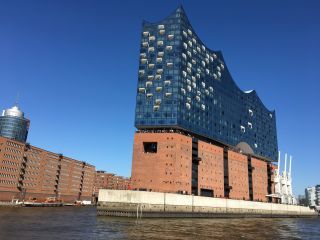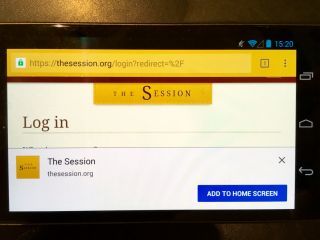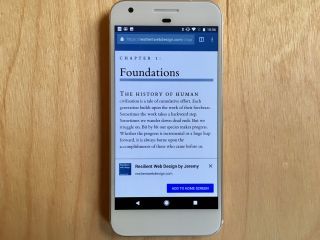Jeremy Keith's Blog, page 55
February 3, 2020
Three books
Lurking: How a Person Became a User by Joanne McNeil will be published on February 25th.
In Lurking, Joanne McNeil digs deep and identifies the primary (if sometimes contradictory) concerns of people online: searching, safety, privacy, identity, community, anonymity, and visibility. She charts what it is that brought people online and what keeps us here even as the social equations of digital life���what we���re made to trade, knowingly or otherwise, for the benefits of the internet���have shifted radically beneath us. It is a story we are accustomed to hearing as tales of entrepreneurs and visionaries and dynamic and powerful corporations, but there is a more profound, intimate story that hasn���t yet been told.
Enemy of All Mankind: A True Story of Piracy, Power, and History���s First Global Manhunt by Steven Johnson will be published on May 12th:
Henry Every was the seventeenth century���s most notorious pirate. The press published wildly popular���and wildly inaccurate���reports of his nefarious adventures. The British government offered enormous bounties for his capture, alive or (preferably) dead. But Steven Johnson argues that Every���s most lasting legacy was his inadvertent triggering of a major shift in the global economy. Enemy of All Mankind focuses on one key event���the attack on an Indian treasure ship by Every and his crew���and its surprising repercussions across time and space. It���s the gripping tale one of the most lucrative crimes in history, the first international manhunt, and the trial of the seventeenth century.
How To Future: Leading and Sense-Making in an Age of Hyperchange by Scott Smith with Madeline Ashby will be published on July 3rd:
Successfully designing for a future requires a picture of that future���a useful map of the horizons ahead that can be used for wayfinding, identifying emerging opportunities or risks. Accurately developing this map means investing in better awareness of signals about the future, understanding trends in context, developing rich insights about what those signals indicate���relative to companies, people, citizens or stakeholders. It also means cultivating ways to share these future insights through tangible yet provocative scenarios or stories, turn these into prototypes, or connect them to strategies.
January 31, 2020
Union
The nation I live in has decided to impose sanctions on itself. The government has yet to figure out the exact details. It won���t be good.
Today marks the day that the ironically-named Kingdom of Great Britain and Northern Ireland officially leaves the European Union. Nothing will change on a day to day basis (until the end of this year, when the shit really hits the fan).
Looking back on 2019, I had the pleasure and privelige of places that will remain in the European Union. Hamburg, D��sseldorf, Utrecht, Miltown Malbay, Kinsale, Madrid, Amsterdam, Paris, Frankfurt, Antwerp, Berlin, Vienna, Cobh.
Maybe I should do a farewell tour in 2020.
January 29, 2020
Architects, gardeners, and design systems
I compared design systems to dictionaries. My point was that design systems���like language���can be approached in a prescriptivist or descriptivist manner. And I favour descriptivism.
A prescriptive approach might give you a beautiful design system, but if it doesn���t reflect the actual product, it���s fiction. A descriptive approach might give a design system with imperfections and annoying flaws, but at least it will be accurate.
I think it���s more important for a design system to be accurate than beautiful.
Meanwhile, over on Frank���s website, he���s been documenting the process of its (re)design. He made an interesting comparison in his post Redesign: Gardening vs. Architecture. He talks about two styles of writing:
In interviews, Martin has compared himself to a gardener���forgoing detailed outlines and overly planned plot points to favor ideas and opportunities that spring up in the writing process. You see what grows as you write, then tend to it, nurture it. Each tendrilly digression may turn into the next big branch of your story. This feels right: good things grow, and an important quality of growth is that the significant moments are often unanticipated.
On the other side of writing is who I���ll call ���the architect������one who writes detailed outlines for plots and believes in the necessity of overt structure. It puts stock in planning and foresight. Architectural writing favors divisions and subdivisions, then subdivisions of the subdivisions. It depends on people���s ability to move forward by breaking big things down into smaller things with increasing detail.
It���s not just me, right? It all sounds very design systemsy, doesn���t it?
This is a false dichotomy, of course, but everyone favors one mode of working over the other. It���s a matter of personality, from what I can tell.
Replace ���personality��� with ���company culture��� and I think you���ve got an interesting analysis of the two different approaches to design systems. Descriptivist gardening and prescriptivist architecture.
Frank also says something that I think resonates with the evergreen debate about whether design systems stifle creativity:
It can be hard to stay interested if it feels like you���re painting by numbers, even if they are your own numbers.
I think Frank���s comparison���gardeners and architects���also speaks to something bigger than design systems…
I gave a talk last year called Building. You can watch it, listen to it, or read the transcript if you like. The talk is about language (sort of). There���s nothing about prescriptivism or descriptivism in there, but there���s lots about metaphors. I dive into the metaphors we use to describe our work and ourselves: builders, engineers, and architects.
It���s rare to find job titles like software gardener, or information librarian (even though they would be just as valid as other terms we���ve made up like software engineer or information architect). Outside of the context of open source projects, we don���t talk much about maintenance. We���re much more likely to talk about making.
Back in 2015, Debbie Chachra wrote a piece in the Atlantic Monthly called Why I Am Not a Maker:
When tech culture only celebrates creation, it risks ignoring those who teach, criticize, and take care of others.
Anyone who���s spent any time working on design systems can tell you there���s no shortage of enthusiasm for architecture and making������let���s build a library of components!���
There���s less enthusiasm for gardening, care, communication and maintenance. But that���s where the really important work happens.
In her article, Debbie cites Ethan���s touchstone:
In her book The Real World of Technology, the metallurgist Ursula Franklin contrasts prescriptive technologies, where many individuals produce components of the whole (think about Adam Smith���s pin factory), with holistic technologies, where the creator controls and understands the process from start to finish.
(Emphasis mine.)
In that light, design systems take their place in a long history of dehumanising approaches to manufacturing like Taylorism. The priorities of ���scientific management��� are the same as those of design systems���increasing efficiency and enforcing consistency.
Humans aren���t always great at efficiency and consistency, but machines are. Automation increases efficiency and consistency, sacrificing messy humanity along the way:
Machine with the strength of a hundred men
Can���t feed and clothe my children.
Historically, we���ve seen automation in terms of physical labour���dock workers, factory workers, truck drivers. As far as I know, none of those workers participated in the creation of their mechanical successors. But when it comes to our work on the web, we���re positively eager to create the systems to make us redundant.
The usual response to this is the one given to other examples of automation: you���ll be free to spend your time in a more meaningful way. With a design system in place, you���ll be freed from the drudgery of manual labour. Instead, you can spend your time doing more important work …like maintaining the design system.
You���ve heard the joke about the factory of the future, right? The factory of the future will have just two living things in it: one worker and one dog. The worker is there to feed the dog. The dog is there to bite the worker if he touches anything.
Good joke.
Everybody laugh.
Roll on snare drum.
Curtains.
January 23, 2020
Web standards, dictionaries, and design systems
Years ago, the world of web standards was split. Two groups���the W3C and the WHATWG���were working on the next iteration of HTML. They had different ideas about the nature of standardisation.
Broadly speaking, the W3C followed a specification-first approach. Figure out what should be implemented first and foremost. From this perspective, specs can be seen as blueprints for browsers to work from.
The WHATWG, by contrast, were implementation led. The way they saw it, there was no point specifying something if browsers weren���t going to implement it. Instead, specs are there to document existing behaviour in browsers.
I���m over-generalising somewhat in my descriptions there, but the point is that there was an ideological difference of opinion around what standards bodies should do.
This always reminded me of a similar ideological conflict when it comes to language usage.
Language prescriptivists attempt to define rules about what���s right or right or wrong in a language. Rules like ���never end a sentence with a preposition.��� Prescriptivists are generally fighting a losing battle and spend most of their time bemoaning the decline of their language because people aren���t following the rules.
Language descriptivists work the exact opposite way. They see their job as documenting existing language usage instead of defining it. Lexicographers���like Merriam-Webster or the Oxford English Dictionary���receive complaints from angry prescriptivists when dictionaries document usage like ���literally��� meaning ���figuratively���.
Dictionaries are descriptive, not prescriptive.
I���ve seen the prescriptive/descriptive divide somewhere else too. I���ve seen it in the world of design systems.
Jordan Moore talks about intentional and emergent design systems:
There appears to be two competing approaches in designing design systems.
An intentional design system. The flavour and framework may vary, but the approach generally consists of: design system first ��� design/build solutions.
An emergent design system. This approach is much closer to the user needs end of the scale by beginning with creative solutions before deriving patterns and systems (i.e the system emerges from real, coded scenarios).
An intentional design system is prescriptive. An emergent design system is descriptive.
I think we can learn from the worlds of web standards and dictionaries here. A prescriptive approach might give you a beautiful design system, but if it doesn���t reflect the actual product, it���s fiction. A descriptive approach might give a design system with imperfections and annoying flaws, but at least it will be accurate.
I think it���s more important for a design system to be accurate than beautiful.
As Matthew Str��m says, you should start with the design system you already have:
Instead of drawing a whole new set of components, start with the components you already have in production. Document them meticulously. Create a single source of truth for design, warts and all.
January 20, 2020
Unity
It’s official. Microsoft’s Edge browser is running on the Blink rendering engine and it’s available now.
Just over a year ago, I wrote about my feelings on this decision:
I���m sure the decision makes sound business sense for Microsoft, but it���s not good for the health of the web.
The importance of browser engine diversity is beautifully illustrated (literally) in Rachel’s The Ecological Impact of Browser Diversity.
But I was chatting to Amber the other day, and I mentioned how I can see the theoretical justification for Microsoft’s decision …even if I don’t quite buy it myself.
Picture, if you will, something I’ll call the bar of unity. It’s a measurement of how much collaboration is happening between browser makers.
In the early days of the web, the bar of unity was very low indeed. The two main browser vendors���Microsoft and Netscape���not only weren’t collaborating, they were actively splintering the languages of the web. One of them would invent a new HTML element, and the other would invent a completely different element to do the same thing (remember abbr and acronym). One of them would come up with one model for interacting with a document through JavaScript, and the other would come up with a completely different model to the same thing (remember document.all and document.layers).
There wasn’t enough collaboration. Our collective anger at this situation led directly to the creation of The Web Standards Project.
Eventually, those companies did start collaborating on standards at the W3C. The bar of unity was raised.
This has been the situation for most of the web’s history. Different browser makers agreed on standards, but went their own separate ways on implementation. That’s where they drew the line.
Now that line is being redrawn. The bar of unity is being raised. Now, a number of separate browser makers���Google, Samsung, Microsoft���not only collaborate on standards but also on implementation, sharing a codebase.
The bar of unity isn’t right at the top. Browsers can still differentiate in their user interfaces. Edge, for example, can���and does���offer very sensible defaults for blocking trackers. That’s much harder for Chrome to do, given that Google are amongst the worst offenders.
So these browsers are still competing, but the competition is no longer happening at the level of the rendering engine.
I can see how this looks like a positive development. In fact, from this point of view, Mozilla are getting in the way of progress by having a separate codebase (yes, this is a genuinely-held opinion by some people).
On the face of it, more unity sounds good. It sounds like more collaboration. More cooperation.
But then I think of situations where complete unity isn’t necessarily a good thing. Take political systems, for example. If you have hundreds of different political parties, that’s not ideal. But if you only have one political party, that’s very bad indeed!
There’s a sweet spot somewhere in between where there’s a base of level of agreement and cooperation, but there’s also plenty of room for disagreement and opposition. Right now, the browser landscape is just about still in that sweet spot. It’s like a two-party system where one party has a crushing majority. Checks and balances exist, but they’re in peril.
Firefox is one of the last remaining representatives offering an alternative. The least we can do is support it.
January 16, 2020
Indie Web Camp London 2020
Do you have plans for the weekend of March 14th and 15th?
If you live anywhere near London, might I suggest that you sign up for Indie Web Camp.
Cheuk and Ana are putting it together with assistance from Calum. As always, there will be one day of Barcamp-style discussions, followed by a fun hands-on day of making.
If you’re wondering whether this is for you, ask yourself if any of this situations apply:
You don’t have your own website yet, but you want one.
You have your own website, but you need some help with it.
You have some ideas about the independent web.
You have your own website but you never seem to find the time to update it.
You’d like to help other people with their websites.
If you recognise yourself in any one of those scenarios, then you should definitely come along to Indie Web Camp London 2020!
January 10, 2020
Install prompt
There’s an interesting thread on Github about the tongue-twistingly named beforeinstallpromt JavaScript event.
Let me back up…
Progressive web apps. You know what they are, right? They’re websites that have taken their vitamins. Specifically, they’re responsive websites that:
are served over HTTPS,
have a web app manifest, and
have a service worker handling the offline scenario.
The web app manifest���a JSON file of metadata���is particularly useful for describing how your site should behave if someone adds it to their home screen. You can specify what icon should be used. You can specify whether the site should launch in a browser or as a standalone app (practically indistinguishable from a native app). You can specify which URL on the site should be used as the starting point when the site is launched from the home screen.
So progressive web apps work just fine when you visit them in a browser, but they really shine when you add them to your home screen. It seems like pretty much everyone is in agreement that adding a progressive web app to your home screen shouldn’t be an onerous task. But how does the browser let the user know that it might be a good idea to “install” the web site they’re looking at?
The Samsung Internet browser does ambient badging���a + symbol shows up to indicate that a website can be installed. This is a great approach!
I hope that Chrome on Android will also use ambient badging at some point. To start with though, Chrome notified users that a site was installable by popping up a notification at the bottom of the screen. I think these might be called “toasts”.
Needless to say, the toast notification wasn’t very effective. That’s because we web designers and developers have spent years teaching people to immediately dismiss those notifications without even reading them. Accept our cookies! Sign up to our newsletter! Install our native app! Just about anything that’s user-hostile gets put in a notification (either a toast or an overlay) and shoved straight in the user’s face before they’ve even had time to start reading the content they came for in the first place. Users will then either:
turn around and leave, or
use muscle memory reach for that X in the corner of the notification.
A tiny fraction of users might actually click on the call to action, possibly by mistake.
Chrome didn’t abandon the toast notification for progressive web apps, but it did change when they would appear. Rather than the browser deciding when to show the prompt���usually when the user has just arrived on the site���a new JavaScript event called beforeinstallprompt can be used.
It’s a bit weird though. You have to “capture” the event that fires when the prompt would have normally been shown, subdue it, hold on to that event, and then re-release it when you think it should be shown (like when the user has completed a transaction, for example, and having your site on the home screen would genuinely be useful). That’s a lot of hoops. Here’s the code I use on The Session to only show the installation prompt to users who are logged in.
The end result is that the user is still shown a toast notification, but at least this time it’s the site owner who has decided when it will be shown. The Chrome team call this notification “the mini-info bar”, and Pete acknowledges that it’s not ideal:
The mini-infobar is an interim experience for Chrome on Android as we work towards creating a consistent experience across all platforms that includes an install button into the omnibox.
I think “an install button in the omnibox” means ambient badging in the browser interface, which would be great!
Anyway, back to that thread on Github. Basically, neither Apple nor Mozilla are going to implement the beforeinstallprompt event (well, technically Mozilla have implemented it but they’re not going to ship it). That’s fair enough. It’s an interim solution that’s not ideal for all reasons I’ve already covered.
But there’s a lot of pushback. Even if the details of beforeinstallprompt are troublesome, surely there should be some way for site owners to let users know that can���or should���install a progressive web app? As a site owner, I have a lot of sympathy for that viewpoint. But I also understand the security and usability issues that can arise from bad actors abusing this mechanism.
Still, I have to hand it to Chrome: even if we put the beforeinstallprompt event to one side, the browser still has a mechanism for letting users know that a progressive web app can be installed���the mini info bar. It’s not a great mechanism, but it’s better than nothing. Nothing is precisely what Firefox and Safari currently offer (though Firefox is experimenting with something).
In the case of Safari, not only do they not provide a mechanism for letting the user know that a site can be installed, but since the last iOS update, they’ve buried the “add to home screen” option even deeper in the “sharing sheet” (the list of options that comes up when you press the incomprehensible rectangle-with-arrow-emerging-from-it icon). You now have to scroll below the fold just to find the “add to home screen” option.
So while I totally get the misgivings about beforeinstallprompt, I feel that a constructive alternative wouldn’t go amiss.
And that’s all I have to say about that.
Except… there’s another interesting angle to that Github thread. There’s talk of allowing sites that are launched from the home screen to have access to more features than a site inside a web browser. Usually permissions on the web are explicitly granted or denied on a case-by-case basis: geolocation; notifications; camera access, etc. I think this is the first time I’ve heard of one action���adding to the home screen���being used as a proxy for implicitly granting more access. Very interesting. Although that idea seems to be roundly rejected here:
A key argument for using installation in this manner is that some APIs are simply so powerful that the drive-by web should not be able to ask for them. However, this document takes the position that installation alone as a restriction is undesirable.
I understand that Chromium or Google may hold such a position but Apple’s WebKit team may not necessarily agree with such a position.
January 6, 2020
Browser defaults
I’ve been thinking about some of the default behaviours that are built into web browsers.
First off, there’s the decision that a browser makes if you enter a web address without a protocol. Let’s say you type in example.com without specifying whether you’re looking for http://example.com or https://example.com.
Browsers default to HTTP rather than HTTPS. Given that HTTP is older than HTTPS that makes sense. But given that there’s been such a push for TLS on the web, and the huge increase in sites served over HTTPS, I wonder if it’s time to reconsider that default?
Most websites that are served over HTTPS have an automatic redirect from HTTP to HTTPS (enforced with HSTS). There’s an ever so slight performance hit from that, at least for the very first visit. If, when no protocol is specified, browsers were to attempt to reach the HTTPS port first, we’d get a little bit of a speed improvement.
But would that break any existing behaviour? I don’t know. I guess there would be a bit of a performance hit in the other direction. That is, the browser would try HTTPS first, and when that doesn’t exist, go for HTTP. Sites served only over HTTP would suffer that little bit of lag.
Whatever the default behaviour, some sites are going to pay that performance penalty. Right now it’s being paid by sites that are served over HTTPS.
Here’s another browser default that Rob mentioned recently: the viewport meta tag:
I thought I might be able to get away with omitting meta name="viewport". Apparently not! Maybe someday.
This all goes back to the default behaviour of Mobile Safari when the iPhone was first released. Most sites wouldn’t display correctly if one pixel were treated as one pixel. That’s because most sites were built with the assumption that they would be viewed on monitors rather than phones. Only weirdos like me were building sites without that assumption.
So the default behaviour in Mobile Safari is assume a page width of 1024 pixels, and then shrink that down to fit on the screen …unless the developer over-rides that behaviour with a viewport meta tag. That default behaviour was adopted by other mobile browsers. I think it’s a universal default.
But the web has changed since the iPhone was released in 2007. Responsive design has swept the web. What would happen if mobile browsers were to assume width=device-width?
The viewport meta element always felt like a (proprietary) band-aid rather than a long-term solution���for one thing, it’s the kind of presentational information that belongs in CSS rather than HTML. It would be nice if we could bid it farewell.
January 2, 2020
The Rise Of Skywalker
If you haven’t seen The Rise Of Skywalker, avert your gaze for I shall be revealing spoilers here…
I wrote about what I thought of The Force Awakens. I wrote about what I thought of The Last Jedi. It was inevitable that I was also going to write about what I think of The Rise Of Skywalker. If nothing else, I really enjoy going back and reading those older posts and reminding myself of my feelings at the time.
I went to a midnight screening with Jessica after we had both spent the evening playing Irish music at our local session. I was asking a lot of my bladder.
I have to admit that my first reaction was …ambivalent. I didn’t hate it but I didn’t love it either.
Now, if that sounds familiar, it’s because that’s pretty much what I said about Rogue One and The Last Jedi:
Maybe I just find it hard to really get into the flow when I���m seeing a new Star Wars film for the very first time.
This time there were very specific things that I could point to and say “I don’t like it!” For a start, there’s the return of Palpatine.
I think the Emperor has always been one of the dullest characters in Star Wars. Even in Return Of The Jedi, he just comes across as a paper-thin one-dimensional villain who’s evil just because he’s evil. That works great when he’s behind the scenes manipulating events, but it makes for dull on-screen shenanigans, in my opinion. The pantomime nature of Emperor Palpatine seems more Harry Potter than Star Wars to me.
When I heard the Emperor was returning, my expectations sank. To be fair though, I think it was a very good move not to make the return of Palpatine a surprise. I had months���ever since the release of the first teaser trailer���to come to terms with it. Putting it in the opening crawl and the first scene says, “Look, he’s back. Don’t ask how, just live with it.” That’s fair enough.
So in the end, the thing that I thought would bug me���the return of Palpatine���didn’t trouble me much. But what really bugged me was the unravelling of one of my favourite innovations in The Last Jedi regarding Rey’s provenance. I wrote at the time:
I had resigned myself to the inevitable reveal that would tie her heritage into an existing lineage. What an absolute joy, then, that The Force is finally returned into everyone���s hands!
What bothered me wasn’t so much that The Rise Of Skywalker undoes this, but that the undoing is so uneccessary. The plot would have worked just as well without the revelation that Rey is a Palpatine. If that revelation were crucial to the story, I would go with it, but it just felt like making A Big Reveal for the sake of making A Big Reveal. It felt …cheap.
I have to say, that’s how I responded to a lot of the kitchen sink elements in this film when I first saw it. It was trying really, really hard to please, and yet many of the decisions felt somewhat lazy to me. There were times when it felt like a checklist.
In a way, there was a checklist, or at least a brief. JJ Abrams has spoken about how this film needed to not just wrap up one trilogy, but all nine films. But did it though? I think I would’ve been happier if it had kept its scope within the bounds of these new sequels.
That’s been a recurring theme for me with all three of these films. I think they work best when they’re about the new characters. I’m totally invested in them. Leaning on nostalgia and the cultural memory of the previous films and their characters just isn’t needed. I would’ve been fine if Luke, Han, and Leia never showed up on screen in this trilogy���that’s how much I’m sold on Rey, Finn, and Poe.
But I get it. The brief here is to tie everything together. And as JJ Abrams has said, there was no way he was going to please everyone. But it’s strange that he would attempt to please the most toxic people clamouring for change. I’m talking about the racists and misogynists that were upset by The Last Jedi. The sidelining of Rose Tico in The Rise Of Skywalker sure reads a lot like a victory for them. Frankly, that’s the one aspect of this film that I’m always going to find disappointing.
Because it turns out that a lot of the other things that I was initially disappointed by evaporated upon second viewing.
Now, I totally get that a film needs to work for a first viewing. But if any category of film needs to stand up to repeat viewing, it’s a Star Wars film. In the case of The Rise Of Skywalker, I think that repeat viewing might have been prioritised. And I’m okay with that.
Take the ridiculously frenetic pace of the multiple maguffin-led plotlines. On first viewing, it felt rushed and messy. I got the feeling that the double-time pacing was there to brush over any inconsistencies that would reveal themselves if the film were to pause even for a minute to catch its breath.
But that wasn’t the case. On second viewing, things clicked together much more tightly. It felt much more like a well-oiled���if somewhat frenetic���machine rather than a cobbled-together Heath Robinson contraption that might collapse at any moment.
My personal experience of viewing the film for the second time was a lot of fun. I was with my friend Sammy, who is not yet a teenager. His enjoyment was infectious.
At the end, after we see Rey choose her new family name, Sammy said “I knew she was going to say Skywalker!”
“I guess that explains the title”, I said. “The Rise Of Skywalker.”
“Or”, said Sammy, “it could be talking about Ben Solo.”
I hadn’t thought of that.
When I first saw The Rise Of Skywalker, I was disappointed by all the ways it was walking back the audacious decisions made in The Last Jedi, particularly Rey’s parentage and the genetic component to The Force. But on second viewing, I noticed the ways that this film built on the previous one. Finn’s blossoming sensitivity keeps the democratisation of The Force on the table. And the mind-melding connection between Rey and Kylo Ren that started in The Last Jedi is crucial for the plot of The Rise Of Skywalker.
Once I was able to get over the decisions I didn’t agree with, I was able to judge the film on its own merits. And you know what? It’s really good!
On the technical level, it was always bound to be good, but I mean on an emotional level too. If I go with it, then I’m rewarded with a rollercoaster ride of emotions. There were moments when I welled up (they mostly involved Chewbacca: Chewie’s reaction to Leia’s death; Chewie getting the medal …the only moment that might have topped those was Han Solo’s “I know”).
So just in case there’s any doubt���given all the criticisms I’ve enumerated���let me clear: I like this film. I very much look forward to seeing it again (and again).
But I do think there’s some truth to what Eric says here:
A friend���s review of ���The Rise of Skywalker���, which also serves as a perfect summary of JJ Abrams��� career: ���A very well-executed lack of creativity.���
I think I might substitute the word “personality” for “creativity”. However you feel about The Last Jedi, there’s no denying that it embodies the vision of one person:
I think the reason why The Last Jedi works so well is that Rian Johnson makes no concessions to my childhood, or anyone else���s. This is his film. Of all the millions of us who were transported by this universe as children, only he gets to put his story onto the screen and into the saga. There are two ways to react to this. You can quite correctly exclaim ���That���s not how I would do it!���, or you can go with it ���even if that means letting go of some deeply-held feelings about what could���ve, should���ve, would���ve happened if it were our story.
JJ Abrams, on the other hand, has done his utmost to please us. I admire that, but I feel it comes at a price. The storytelling isn’t safe exactly, but it’s far from personal.
The result is that The Rise Of Skywalker is supremely entertaining���especially on repeat viewing���and it has a big heart. I just wish it had more guts.
January 1, 2020
2019
So that was 2019. Quite a year.
Looking back, there were some real highlights for me…
Going to CERN in February to be part of the project to recreate the first web browser was like a dream come true. It really was an honour and a privilege to be part of it.
In July, I returned to Miltown Malbay for the Willie Clancy Summer School after an unreasonably long hiatus of fifteen years. I had a great time immersed in traditional Irish music.
In August, Jessica and I crossed the Atlantic on board the Queen Mary 2. That was an unforgettable experience.
Then there were the usual benefits that come with speaking at international conferences like An Event Apart and Beyond Tellerrand. I got to visit interesting places, eat excellent food, and meet good people.
Not everything was rosy. There were some sad life events for friends and family. And of course the whole political situation here in the UK has been just awful in 2019.
So onwards to 2020. I need to remind myself that many things are going well in the world but it can be hard to keep that in mind. At a local���nay, parochial���level, there’s a good chance that 2020 will deliver a hard Brexit. I have no faith in the competence or motivations of the current government to do otherwise (I keep reminding myself that I don’t have to stay in this country if it falls apart). And at the global scale, our attempts to mitigate the climate crisis are proceeding too slowly.
That’s something I need to take more personal responsibility for in 2020: fewer plane journeys, more trains, and more carbon offsetting.
Ultimately, it’s a fairly arbitrary moment in time but I do like to pause for a moment and look back at the year that’s just been. For all its faults, I have happy memories. I’m healthy. I played lots of music. I ate well. I spent time with friends and family.
I look forward to more of that in the third decade of the 21st century.
Jeremy Keith's Blog
- Jeremy Keith's profile
- 55 followers




















